25.10.2023
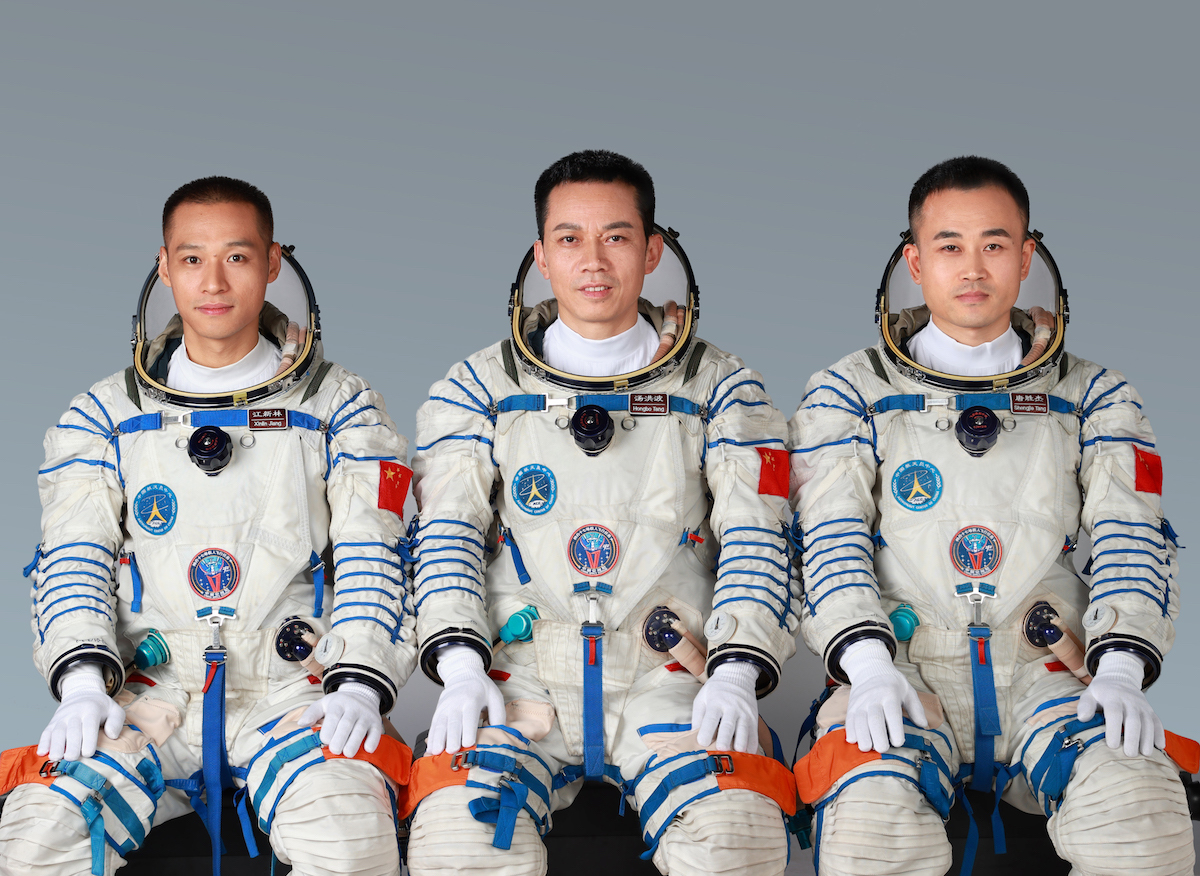
This undated photo shows Chinese astronauts Tang Hongbo (C), Tang Shengjie (R) and Jiang Xinlin who will carry out the Shenzhou-17 spaceflight mission. Chinese astronauts Tang Hongbo, Tang Shengjie, and Jiang Xinlin will carry out the Shenzhou-17 manned spaceflight mission, and Tang Hongbo will be the commander, the China Manned Space Agency announced at a press conference on Wednesday. (Xinhua)
The Shenzhou-17 crewed spaceship is scheduled to be launched at 11:14 a.m. Thursday (Beijing Time) from the Jiuquan Satellite Launch Center in northwest China, announced the China Manned Space Agency on Wednesday.
Shenzhou-17 crew unveiled
Chinese astronauts Tang Hongbo, Tang Shengjie, and Jiang Xinlin will carry out the Shenzhou-17 manned spaceflight mission, and Tang Hongbo will be the commander.
Tang Hongbo
As the commander of the Shenzhou-17 mission, Tang Hongbo will be the first astronaut to return to China's space station.
Tang joined the second batch of Chinese astronauts in 2010, and flied to space for the first time in the three-month Shenzhou-12 mission in June 2021, the first crewed mission for China's space station construction.
Tang Shengjie & Jiang Xinlin
Tang Shengjie and Jiang Xinlin are new comers to space. They joined China's third batch of astronauts in September 2020.
The crew will stay in orbit for about six months.
Main tasks
The Shenzhou-17 astronauts will perform various in-orbit space science and application payload tests and experiments.
They will carry out extravehicular activities, install extravehicular payloads and conduct space station maintenance and other tasks.
For the first time, the astronauts will do extravehicular experimental maintenance.
Extension module to be launched
China will launch an extension module at an appropriate time and upgrade the basic configuration of the space station from the current T shape to a cross shape.
The extension module will install space science experiment cabinets and large extra-vehicular experiment equipment in multiple fields with expanded application scale to meet the new needs of space science research and application.
Shenzhou-16 crew to return on Oct. 31
The Shenzhou-16 crew is scheduled to return to the Dongfeng landing site on Oct. 31, after completing the in-orbit work handover to the Shenzhou-17 crew.
Quelle: Xinhua
+++
China discloses tasks of Shenzhou-17 crewed space mission
The Shenzhou-17 astronauts will perform various in-orbit space science and application payload tests and experiments, a senior official from the China Manned Space Agency (CMSA) announced at a press conference on Wednesday.
They will carry out extravehicular activities (EVAs), install extravehicular payloads and conduct space station maintenance and other tasks, said Lin Xiqiang, deputy director of the CMSA.
The Shenzhou-17 astronauts will do extravehicular experimental maintenance for the first time, which is a very challenging task, Lin added.
With space debris increasing, their impact on long-term operating spacecraft is inevitable, Lin said. "Through preliminary inspections, we have found that the solar wings of the space station had been hit by tiny space particles several times, causing minor damages."
"Of course, we already took this into consideration in the design stage. At present, all functionality and performance indicators of the space station meet requirements," he added.
Lin said extravehicular experimental maintenance is geared towards the long-term operation of the space station and the verification of its technical capabilities.
The astronauts will also continue to assess the functioning and performance of the space station and test the coordination and compatibility of ground support centers in performing space station operation and management tasks, to further enhance the operating efficiency and fault correction capability of the space station, he said.
The Shenzhou-17 crewed spaceship is scheduled to be launched at 11:14 a.m. Thursday (Beijing Time) from the Jiuquan Satellite Launch Center in northwest China.
The Shenzhou-17 crew consisting of Tang Hongbo, Tang Shengjie and Jiang Xinlin, will take over from the in-orbit Shenzhou-16 crew, and will spend about six months on the space station, Lin said.
According to the official, the Shenzhou-16 mission has progressed smoothly. Its crew has carried out a total of 70 space experiments in areas such as aerospace medicine, life ecology, biotechnology, materials science, fluid physics and others, as well as eight research efforts on human-factors engineering.
The Shenzhou-16 crew also once performed an EVA, delivered a lecture from the space station, and assisted with the separation of the Tianzhou-5 cargo craft from the space station combination during their stay in orbit, he added.
Quelle: Xinhua
+++
Private sector actively competing for involvement in China's space station, manned lunar missions
China's private space enterprises are hopeful that commercial rockets developed by them will be involved in the launch missions of the low-cost cargo transport vehicle for the country's space station, announced a senior official with the China Manned Space Agency (CMSA) at a press conference on Wednesday.
In proposals provided by space enterprises for China's space station low-cost cargo transport system program, many enterprises chose the plans developed by private commercial space rocket companies, said Lin Xiqiang, deputy director of the CMSA.
The transport capacity of these commercial rockets ranges from 4 tonnes to 6 tonnes, with very high comprehensive cost performance. They are expected to participate in the next phase of commercial procurement, he added.
Five state-owned enterprises and four private commercial companies submitted a total of 10 proposals for the cargo transport system program. After evaluation, four proposals entered the design stage.
Lin also mentioned that after the CMSA had solicited proposals for the manned lunar rover, many universities, automobile enterprises and scientific research institutions in China had jointly set up teams to carry out design work.
A total of 14 teams, formed by more than 40 enterprises, research institutes and universities, submitted proposals and 11 teams have passed the first-round review for further evaluation.
The CMSA is very happy to see that China's private commercial space companies are developing rapidly, and are actively participating in manned space missions, he added.
Quelle: Xinhua
----
Update: 26.10.2023
.
Profile: Tang Shengjie -- China's youngest astronaut to enter space station
China is ready to launch the Shenzhou-17 crewed spaceship on Thursday, with Tang Shengjie, the country's youngest astronaut to enter the space station, serving as one of its crew members.
"It is a great honor and great duty for me, and I feel very lucky and very happy," Tang said when meeting the press Wednesday at the Jiuquan Satellite Launch Center in northwest China.
Born into a farming family in December 1989 in northwest China's Gansu Province, Tang often helped his mother do farm work, and he learned to plow the land at a very young age.
It took him a long time to walk to his school along a mountain road and he had to do so for eight years.
From a young age, Tang had shown considerable hands-on ability. Every time when the family bought a new electrical appliance, he would take it apart and tinker with it. Villagers often asked Tang to repair their broken electrical appliances.
After graduation from high school, he entered China's Aviation University of Air Force and became a fighter pilot. After nearly 13 years of service, he had flown six types of aircraft.
In 2018, China began to recruit its third batch of astronauts. Tang signed up for it. In September 2020, he was included in the third batch of astronauts.
Thanks to his childhood hobby of tinkering with electrical appliances, Tang proved good at the professional skills training needed by astronauts. Every time there was an operational course, Tang would feel very excited.
For example, during underwater training designed for extravehicular activities, he had to wear a heavy underwater suit and conduct simulated weightlessness training for five or six hours, while doing operation activities requiring extensive use of his upper limbs.
After training, he was often too fatigued to hold chopsticks. But he never got tired of training.
Two years of hard training finally earned him a ticket to space. In June 2022, Tang was selected as a crew member for the Shenzhou-17 mission.
Tang loves photography. Now he is looking forward to watching the blue planet from a different perspective in space and recording the wonders of the universe.
"What I think about more is how to complete the tasks, get scientific experiment results, do explorations, and make some contributions to the manned space mission and scientific development of our country," said Tang, when talking about the coming space mission.
Quelle: Xinhua
+++
Profile: Tang Hongbo, ready to revisit China's space station
Tang Hongbo, a veteran astronaut who completed his first spaceflight about two years ago, is poised for a new space mission.
Appointed to the position of the Shenzhou-17 commander, Tang is slated to be the first space traveler to revisit China's Tiangong space station. He will also become the quickest space returnee to date among the country's astronauts.
"I am confident in, committed to and capable of accomplishing the Shenzhou-17 mission with two crewmates," said Tang, who stood between two space rookies, at Wednesday's press conference.
The trio of astronauts, the youngest crew in China's manned spaceflight history, is ready and waiting to be launched via the Shenzhou-17 spaceship and start a six-month mission that is projected to carry out the space station's first extravehicular experimental maintenance.
SHENZHOU-12 MISSION
Tang, born in 1975 and launched into orbit on the Shenzhen-12 mission in June 2021, became one of the first occupants of the Chinese space station's core module Tianhe.
"Tang is modest and always eager to learn. I have full confidence in this crew, and I trust Tang very much," said Shenzhou-12's commander Nie Haisheng.
Now, the space complex Tang is going to return to has been extended into a versatile space lab with two additional modules and more sophisticated experimental facilities.
During their three-month manned mission back in 2021, the Shenzhou-12 crew tested key technologies for the construction and operation of the space station, long-term stays of astronauts, recycling and life support systems, supply of space materials, extravehicular activities (EVAs) and operations, and in-orbit maintenance.
In July that year, Tang and his crewmate Liu Boming did a seven-hour space walk to accomplish tasks including equipment installation and panoramic camera lifting.
During the extravehicular emergency drill, Tang maintained good balance and crawled carefully to avoid equipment in the cabin. He completed the task in just over 10 minutes, quicker than the fastest time recorded during simulation training on Earth.
Amid his intense tasks, Tang also spiced up his first space trip with much fun, and this turned him into a star on China's social media platforms.
A popular video clip that went viral on Bilibili, one of China's largest video-sharing websites, saw Tang munching an apple while working in the space station.
When Tang flaunted an apple to his son during a video call, it disappeared in the blink of an eye. The crew had to do a thorough search before finally finding it behind a cabinet. The apple played hide-and-seek, Tang said self-mockingly.
Tang is a shutterbug. A candid photo revealed the moment when Tang bent down on a berth in Tiangong to take pictures from the cabin window using his cellphone. After returning to Earth, he presented his photos of a stunning moon above the horizon as a gift for the public during the Mid-Autumn Festival.
In a space lecture delivered for teenagers who started their fall semester in September 2021, Tang produced an eye-catching stunt by using a pair of chopsticks to pick up jelly-like beads of tea water floating in space.
Tang also displayed a sprouted sweet potato from his hometown which he took with him into space. He invited his young TV audience on Earth to join him in a potato-growing contest.
HEROIC ASTRONAUT
On Sept. 16, 2021, when Tang was about to leave Tianhe, he felt reluctant to part with his space home and took another tour of the module, making up his mind to return to it soon.
"I'm staying true to my mission to do a spaceflight for my country," said Tang at the press conference. "It never changes, and I have never slacked off."
Tang completed his body recovery, mental adjustment and new training as soon as possible. He was selected for the Shenzhou-17 mission within a year after returning to Earth.
"Now, I cannot wait to go back and see the changes on the space home," said Tang.
As a new commander, Tang gave a rule of thumb to his crewmates -- to err is human and therefore following the handbook closely is always the golden rule.
"A mouth-wipe or tableware, for instance, must all be put back in their assigned places," said Tang. "Otherwise, it can drift away without you noticing."
Tang was born into a rural family in the central Chinese city of Xiangtan, the birthplace of late Chinese leader Mao Zedong, whose outstanding achievements inspired Tang from childhood to become a hero.
Tang joined the People's Liberation Army in 1995 and clocked more than 1,000 safe flight hours. He was included in the second candidate pool of Chinese astronauts in 2010, and secured his first spaceflight mission after 11 years of strenuous learning, training and testing.
"Life is a long journey, so don't give up on your dreams because of difficulties and obstacles," Tang once encouraged youngsters.
He was awarded the third-class medal and the honorary title "heroic astronaut" for his service to China's space endeavors.
Quelle: Xinhua
+++
Profile: Jiang Xinlin, from tank driver to taikonaut
The orbiting Tiangong space station will this week welcome its new residents, with rookie taikonaut Jiang Xinlin set to check in for a six-month stay alongside two other crew members.
"I am very much looking forward to the space travel, to enjoying the fun in zero gravity and exploring the wonders of the vast universe," the 35-year-old said in a pre-flight interview.
China is set to launch the Shenzhou-17 manned spaceship on Thursday, sending taikonauts Tang Hongbo, Tang Shengjie and Jiang Xinlin to its space station to conduct various space science and application payload tests and experiments.
Like many of his predecessors, Jiang is a pilot-turned-taikonaut. But before reaching beyond the sky, he was also a ground-force tank driver.
Following his high school graduation in 2006, Jiang enrolled in an armored engineering institute of the People's Liberation Army. Training in harsh environments honed his operational skills and physical strength.
Controlling a heavy tank on the ground is similar to the underwater training that taikonauts undertake, with both requiring upper body strength, Jiang said.
The Air Force began recruiting pilots from military schools four years later, and Jiang was selected to become a fighter pilot trainee by the Aviation University of the Air Force, where he soon proved his extraordinary courage and skill.
Jiang won fame at the university by executing a safe emergency brake maneuver when he realized his engine speed indicator was abnormal just as he was beginning to take off. The beginner pilot did not hesitate and throttled down the engine decisively, opened the decelerating umbrella, braked to decelerate, and completed a smooth stop on the runway.
Years of hard work led Jiang to become increasingly fascinated by flight and cultivated his dream of soaring higher. In 2018, when China began recruiting its third group of taikonauts, Jiang applied for the selection.
He stood out and joined the taikonaut candidate pool in September 2020. Jiang has since received training that is much tougher than that undertaken by pilots.
He said that one of the most challenging exercises was sitting in the rotating chair, which is used for balance training to help reduce the effects of zero gravity on the human body in space. Jiang did not do very well at first, often feeling dizzy and sick, so he voluntarily undertook extra practice for several more weeks to improve his performance.
He excelled in field survival training and made significant efforts after being slated to join the upcoming Shenzhou-17 mission. His training tips and study of body language won recognition from his crewmates.
Born in a rural part of central China's Henan Province in 1988, Jiang has faced challenges since childhood. When he was young, he and his elder brother worked after-school jobs to lighten the burden on his parents.
Calm, candid and modest, the taikonaut said at a press conference on Wednesday that achieving his space dream is an "incredible honor," and that the country's development in the new era has provided him with the precious opportunity to showcase his skills.
He said he will cherish this opportunity to fly into space and fulfill his duty.
Quelle: Xinhua
+++
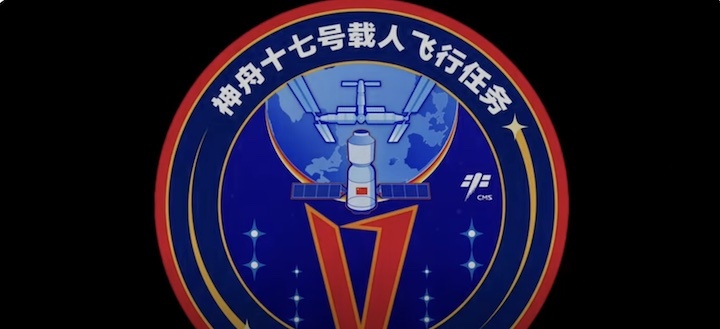
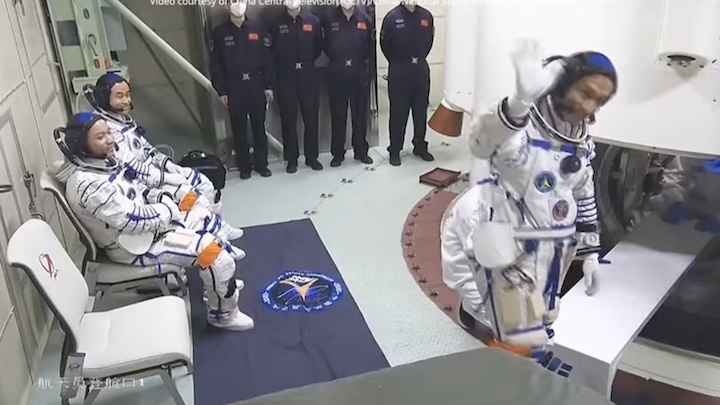
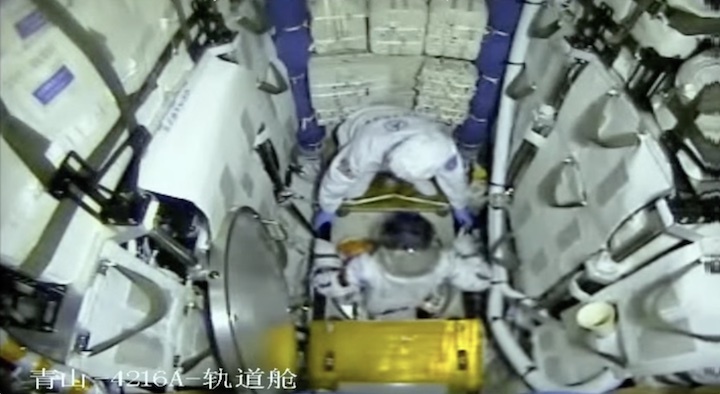
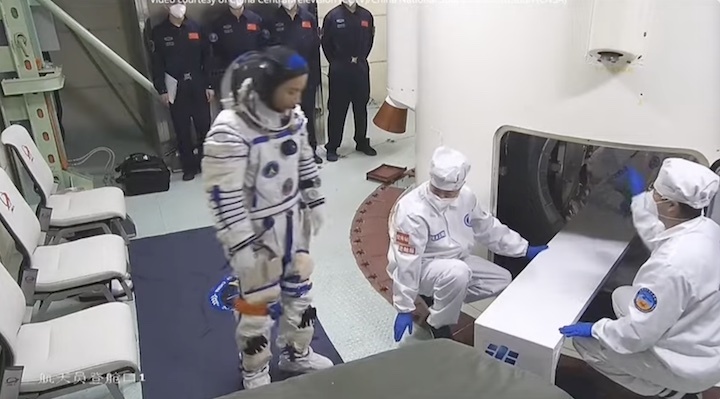
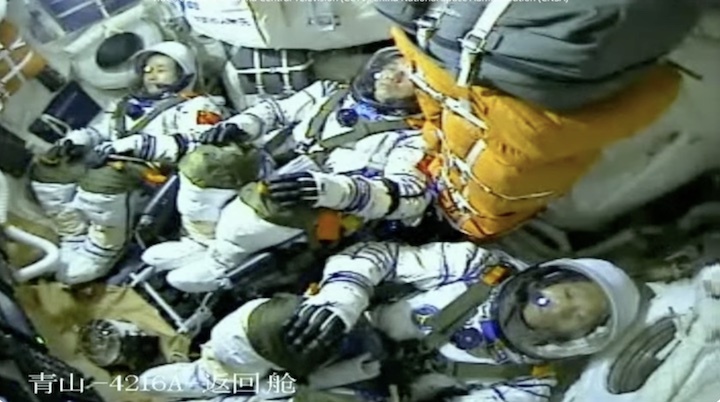
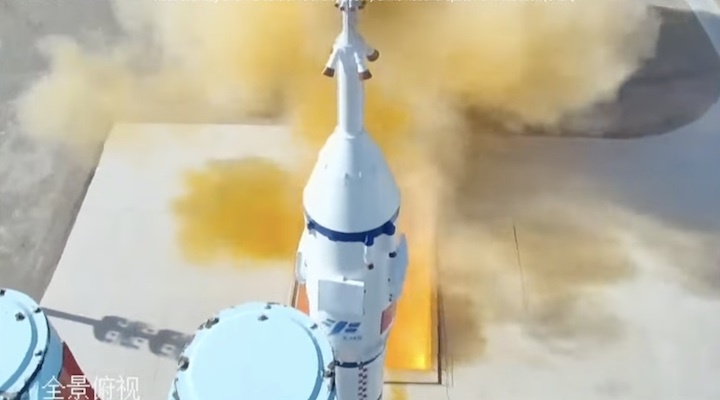
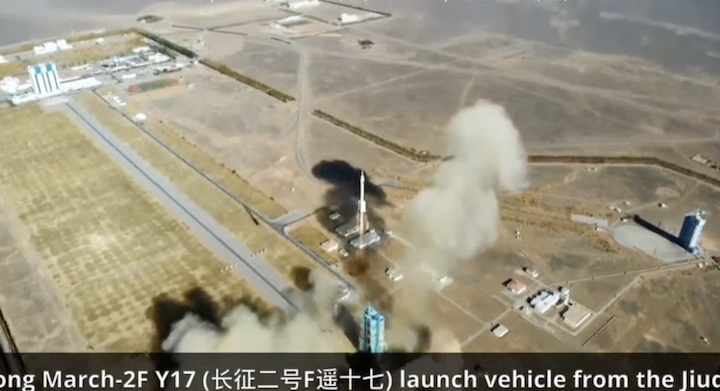
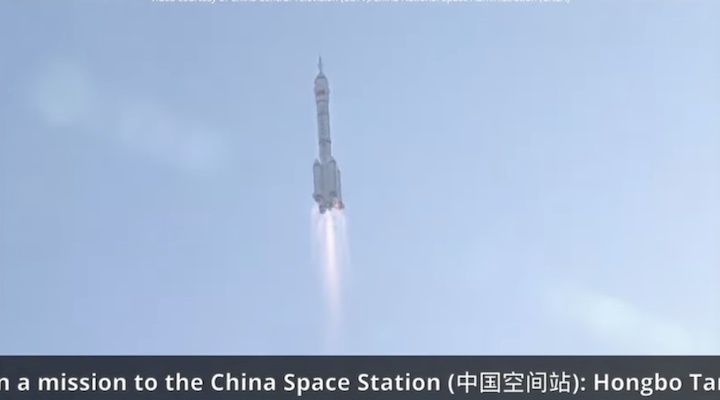
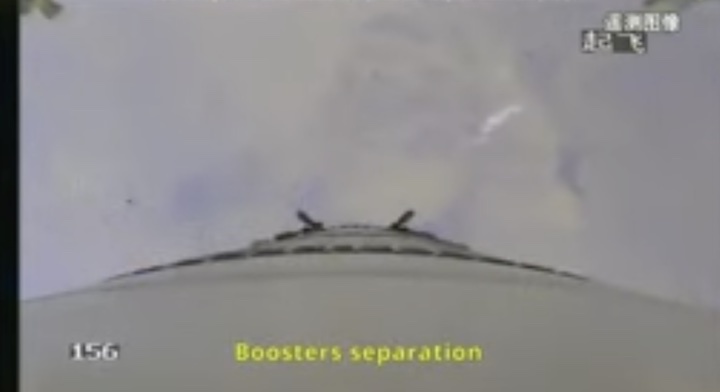
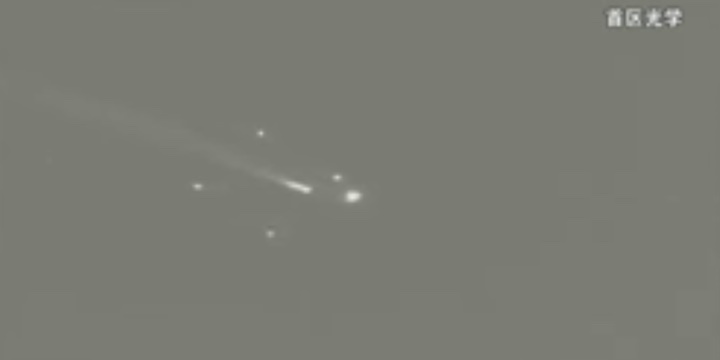
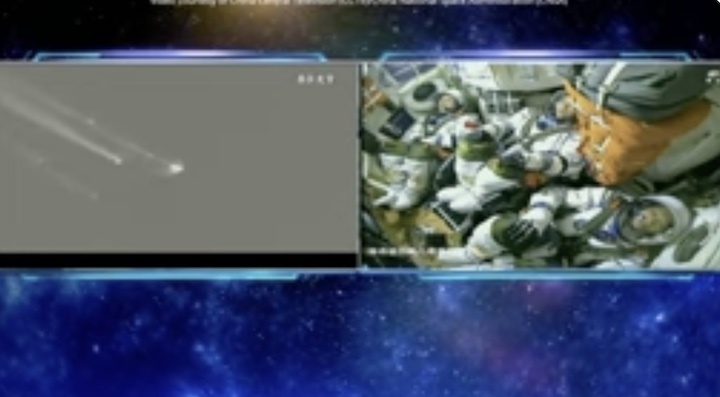
Quelle: YouTube
